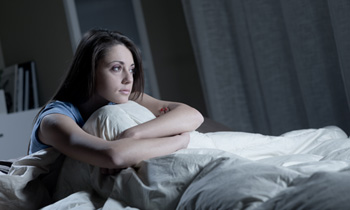Sleep Disorders and Problems
Sleep Disorders and Problems
Symptoms, Treatment, and Self-Help
 Many of us experience trouble sleeping at one time or another. Usually it’s due to stress, travel, illness, or other temporary interruptions to your normal routine. But if sleep problems are a regular occurrence and interfere with your daily life, you may be suffering from a sleep disorder. Sleep disorders cause more than just daytime sleepiness. They can take a serious toll on your mental and physical health, leading to memory problems, weight gain, and a negative impact on your energy and mood. But you don’t have to live with a sleeping problem. There are many actions you can take to ensure a good night’s sleep and improve your health.
Many of us experience trouble sleeping at one time or another. Usually it’s due to stress, travel, illness, or other temporary interruptions to your normal routine. But if sleep problems are a regular occurrence and interfere with your daily life, you may be suffering from a sleep disorder. Sleep disorders cause more than just daytime sleepiness. They can take a serious toll on your mental and physical health, leading to memory problems, weight gain, and a negative impact on your energy and mood. But you don’t have to live with a sleeping problem. There are many actions you can take to ensure a good night’s sleep and improve your health.
What is a sleep disorder or sleep problem?
A sleep disorder is a condition that frequently impacts your ability to get enough quality sleep. While it’s normal to occasionally experience difficulties sleeping, it’s not normal to regularly have problems getting to sleep at night, to wake up feeling exhausted, or to feel sleepy during the day.
Frequently having trouble sleeping can be a frustrating and debilitating experience. You sleep badly at night, which leaves you feeling dead-tired in the morning and whatever energy you have quickly drains throughout the day. But then, no matter how exhausted you feel at night, you still have trouble sleeping. And so the cycle begins again, taking a serious toll on your mood, energy, efficiency, and ability to handle stress. Ignoring sleep problems and disorders can damage your physical health and lead to weight gain, car accidents, impaired job performance, memory problems, and strained relationships. If you want to feel your best, stay healthy, and perform up to your potential, quality sleep is a necessity, not a luxury.
Even if you’ve struggled with sleep problems for so long that it seems normal, you can still learn to sleep better. You can start by tracking your symptoms and sleep patterns, and then making healthy changes to your daytime habits and bedtime routine. If self-help doesn’t do the trick, you can turn to sleep specialists who are trained in sleep medicine. Together, you can identify the underlying causes of your sleeping problem and find ways to improve your sleep and quality of life.
Signs and symptoms of a sleep disorder
Everyone experiences occasional sleeping problems, so how can you tell whether your difficulty is just a minor, passing annoyance or a sign of a more serious sleep disorder or underlying medical condition?
Start by scrutinizing your symptoms, looking especially for the telltale daytime signs of sleep deprivation.
Is it a sleep disorder?
Do you…
- feel irritable or sleepy during the day?
- have difficulty staying awake when sitting still, watching television or reading?
- fall asleep or feel very tired while driving?
- have difficulty concentrating?
- often get told by others that you look tired?
- react slowly?
- have trouble controlling your emotions?
- feel like you have to take a nap almost every day?
- require caffeinated beverages to keep yourself going?
If you are experiencing any of the above symptoms on a regular basis, you may be dealing with a sleep disorder. The more you answered “yes”, the more likely it is that you have a sleep disorder.
Types of common sleep disorders
Insomnia
Insomnia, the inability to get to sleep or sleep well at night, can be caused by stress, jet lag, a health condition, the medications you take, or even the amount of coffee you drink. Insomnia can also be caused by other sleep disorders or mood disorders such as anxiety and depression.
Whatever the cause of your insomnia, improving your sleep hygiene, revising your daytime habits, and learning to relax will help cure most cases of insomnia without relying on sleep specialists or turning to prescription or over-the-counter sleeping pills.
Sleep apnea
Sleep apnea is a common (and treatable) sleep disorder in which your breathing temporarily stops during sleep, awakening you frequently. If you have sleep apnea you may not remember these awakenings, but you’ll likely feel exhausted during the day, irritable and depressed, or see a decrease in your productivity. Sleep apnea is a serious and potentially life-threatening sleep disorder, so see a doctor right away and learn how to help yourself.
Restless legs syndrome (RLS)
Restless legs syndrome (RLS) is a sleep disorder that causes an almost irresistible urge to move your legs (or arms) at night. The urge to move occurs when you’re resting or lying down and is usually due to uncomfortable, tingly, aching, or creeping sensations. There are plenty of ways to help manage and relieve symptoms, though, including self-help remedies you can use at home.
Narcolepsy
Narcolepsy is a sleep disorder that involves excessive, uncontrollable daytime sleepiness. It is caused by a dysfunction of the brain mechanism that controls sleeping and waking. If you have narcolepsy, you may have “sleep attacks” in the middle of talking, working, or even driving. Although no cure yet exists, a combination of treatments can help control symptoms and enable you to enjoy many normal activities.
Circadian rhythm sleep disorders
We all have an internal biological clock that regulates our 24-hour sleep-wake cycle, also known as our
circadian rhythms. Light is the primary cue that influences circadian rhythms. At night, when there is less light, your brain triggers the release of melatonin, a hormone that makes you sleepy. When the sun comes up in the morning, the brain tells the body that it’s time to wake up.
When your circadian rhythms are disrupted or thrown off, you may feel groggy, disoriented, and sleepy at inconvenient times. Circadian rhythms have been linked to a variety of sleeping problems and sleep disorders, as well as depression, bipolar disorder, and seasonal affective disorder (the winter blues).
Shift work sleep disorder
Shift work sleep disorder occurs when your work schedule and your biological clock are out of sync. In our 24-hour society, many people have to work night shifts, early morning shifts, or rotating shifts. These schedules force you to work when your body is telling you to go to sleep, and sleep when your body is signaling you to wake.
While some people adjust better than others to the demands of shift work, most shift workers get less quality sleep than their daytime counterparts. As a result of sleep deprivation, you may struggle with sleepiness and mental lethargy on the job. This cuts into your productivity and puts you at risk of injury.
To reduce the impact of shift work on your sleep:
- Take regular breaks and minimize the frequency of shift changes
- When changing shifts, request a shift that’s later, rather than earlier as it’s easier to adjust forward in time, rather than backward.
- Naturally regulate your sleep-wake cycle by increasing light exposure at work (use bright lights) and limiting light exposure when it’s time to sleep. Avoid TV and computer screens, and use blackout shades or heavy curtains to block out daylight in your bedroom.
- Consider taking melatonin when it’s time for you to sleep.
Delayed sleep phase disorder
Delayed sleep phase disorder is a condition where your biological clock is significantly delayed. As a result, you go to sleep and wake up much later than other people. This is more than just a preference for staying up late or being a night owl, but rather a disorder that makes it difficult for you to keep normal hours—to make it to morning classes, get the kids to school on time, or keep a 9-to-5 job.
- People with delayed sleep phase disorder are unable to get to sleep earlier than 2 to 6 a.m., no matter how hard they try.
- When allowed to keep their own hours (such as during a school break or vacation), they fall into a regular sleep schedule.
- Delayed sleep phase disorder is most common in teenagers, and many teens will eventually grow out of it.
- For those who continue to struggle with a biological clock that is out of sync, treatments such as light therapy and chronotherapy can help. To learn more, schedule an appointment with your doctor or a local sleep clinic.
Jet lag
Jet lag is a temporary disruption in circadian rhythms that occurs when you travel across time zones. Symptoms include daytime sleepiness, fatigue, headaches, stomach problems, and insomnia. Symptoms are more pronounced the longer the flight and flying east tends to cause worse jet lag than flying west.
In general, it usually takes one day per time zone crossed to adjust to the local time. So, if you flew from Los Angeles to New York, crossing three time zones, your jet lag should be gone within three days.
Tracking your symptoms
The first step to overcoming a sleep disorder or problem is identifying and carefully tracking your symptoms and sleep patterns.
Keep a sleep diary
A sleep diary can pinpoint day and nighttime habits that may contribute to your problems at night. Keeping a record of your sleep patterns and problems will also prove helpful if you eventually need to see a sleep doctor.
Your sleep diary should include:
- what time you went to bed and woke up
- total sleep hours and perceived quality of your sleep
- a record of time you spent awake and what you did (“got up, had a glass of milk, and meditated” for example)
- types and amount of food, liquids, caffeine, or alcohol you consumed before bed, and times of consumption
- your feelings and moods before bed (happiness, sadness, stress, anxiety)
- any drugs or medications taken, including dose and time of consumption
The details can be important, revealing how certain behaviors can be ruining your chance for a good night’s sleep. After keeping the diary for a week, for example, you might notice that when you have more than one glass of wine in the evening, you wake up during the night.
Download or print HelpGuide’s sleep diary (PDF).
Self-help for sleep disorders
While some sleep disorders may require a visit to the doctor, you can improve many sleeping problems on your own.
Improve your daytime habits. Regardless of your sleep problems, sticking to a consistent sleep schedule, getting regular exercise, limiting your intake of caffeine, alcohol, and nicotine, and managing stress will translate into better sleep over the long term.
Develop a relaxing bedtime routine to prepare your mind and body for sleep. Make sure your bedroom is quiet, dark, and cool, avoid heavy meals and too many fluids late at night, take a warm bath, read, or listen to soothing music to unwind, and turn off screens at least one hour before bedtime.
Get back to sleep when you wake up at night. Whether you have a sleep disorder or not, it’s normal to wake briefly during the night. If you’re having trouble getting back to sleep, try focusing on your breathing, meditating, or practicing another relaxation technique. Make a note of anything that’s worrying you and resolve to postpone worrying about it until the next day when it will be easier to resolve.
When to call a doctor
If you’ve tried a variety of self-help remedies without success, schedule an appointment with a sleep specialist or ask your family doctor for a referral to a sleep clinic, especially if:
- Your main sleep problem is daytime sleepiness and self-help hasn’t improved your symptoms.
- You or your bed partner gasps, chokes, or stops breathing during sleep.
- You sometimes fall asleep at inappropriate times, such as while talking, walking, or eating.
Provide your doctor with as much supporting information as possible, including information from your sleep diary.
What to expect at a sleep clinic or center
A specialist will observe your sleep patterns, brain waves, heart rate, rapid eye movements and more using monitoring devices attached to your body. While sleeping with a bunch of wires attached to you might seem difficult, most patients find they get used to it quickly.
The sleep specialist will then design a treatment program if necessary. A sleep center can also provide you with equipment to monitor your activities (awake and asleep) at home.
Where to turn for help
Find a sleep center
In the U.S., use the sleep center locator to find a sleep center near you. (American Academy of Sleep Medicine)
In the UK, find sleep clinics, centres, and specialists. (UK Health Centre)
In Canada, find a sleep clinic or treatment provider. (Canada Sleep Society)
In Australia, find a list of sleep clinics. (Sleep Disorders Australia)
Recommended reading
Improving Sleep – A guide to a good night’s rest. (Harvard Medical School Special Health Report)
An Overview of Sleep Disorders – Symptoms and treatment of common sleep disorders. (Division of Sleep Medicine, Harvard Medical School)
Problem Sleepiness (PDF) – Including symptoms, causes, and link to common sleep disorders. (National Heart, Lung, and Blood Institute, National Institutes of Health)
Sleep Problems in Children – Common sleep issues with babies, young children, and teenagers. (University of Michigan Health System)
Authors: Melinda Smith, M.A., Lawrence Robinson, and Robert Segal, M.A. Last updated: October 2018.
Source: Internet





